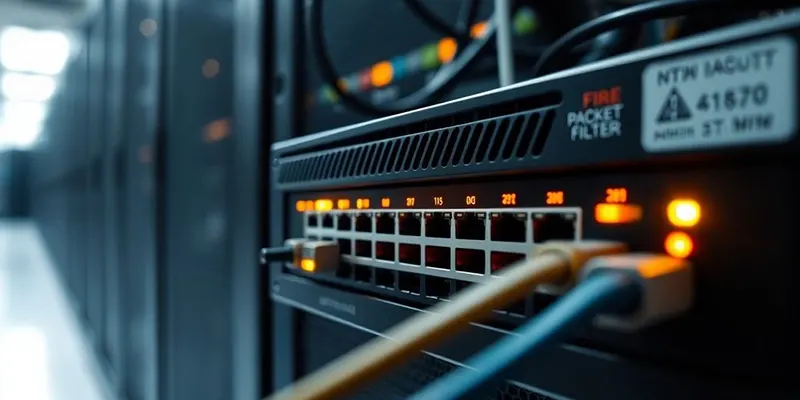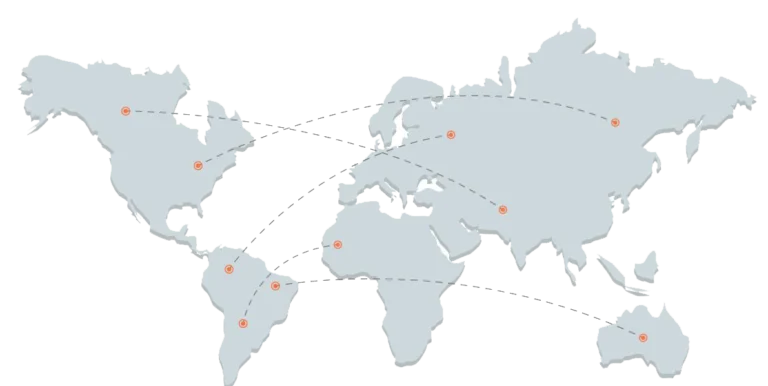What Is a Packet Filtering Firewall?
A packet filtering firewall is a type of network security tool that controls the flow of data packets entering or leaving a network. It uses a set of rules to decide whether to allow or block these packets. This process helps protect the network from unwanted access and potential threats.
Key Components of Packet Filtering
Packet filtering firewalls mainly focus on two parts of each packet:
- Packet Header: This contains important information like the source and destination IP addresses.
- Payload: This is the actual data being sent, but packet filters usually do not analyze this part.
The firewall checks the packet header against predefined rules, which can include:
- Source and destination IP addresses
- Port numbers
- Protocols used (like TCP or UDP)
How Packet Filtering Differs from Other Firewalls
Unlike more advanced firewalls, packet filtering firewalls do not inspect the contents of the packets. They operate at a basic level, making decisions based solely on the header information. This means they are generally faster but may miss some threats that require deeper inspection.
Packet filtering firewalls are essential for basic network security, but they should be part of a broader security strategy to ensure comprehensive protection.
How Packet Filtering Firewalls Work
Packet Header Analysis
A packet filtering firewall works by examining the packet header of each data packet that tries to enter or leave the network. The header contains important information such as:
- Source IP address: Where the packet is coming from.
- Destination IP address: Where the packet is going.
- Protocol type: This could be TCP, UDP, or ICMP.
- Port numbers: These act like doors for the data, determining which application the packet is associated with.
Rule-Based Filtering
The firewall uses a set of predefined rules to decide whether to allow or block a packet. If a packet matches the rules, it is allowed through; if not, it is blocked. This process helps maintain network security by ensuring that only authorized packets can pass through.
Firewall administrators create packet filtering firewall rules to prevent packet transmission and only allow packets that match specific IP addresses or ports.
Bidirectional Traffic Management
Packet filtering firewalls can manage both incoming and outgoing traffic. This means they can prevent unauthorized access from outside sources while also stopping internal threats from communicating outward. This bidirectional approach is crucial for maintaining a secure network environment.
In summary, packet filtering firewalls are essential tools for network security, providing a first line of defense against unauthorized access.
Advantages of Using Packet Filtering Firewalls
Enhanced Network Security
Packet filtering firewalls play a crucial role in protecting networks from unauthorized access. They analyze incoming and outgoing data packets, allowing or blocking them based on predefined rules. This helps in preventing malicious traffic from entering the network.
Cost Efficiency
One of the main benefits of packet filtering firewalls is their cost-effectiveness. Many of these firewalls come integrated into existing network devices, which means businesses can save money by not needing separate firewall hardware. This makes them a popular choice for small to medium-sized enterprises.
Performance Benefits
Packet filtering firewalls are known for their fast processing speeds. They make quick decisions on whether to allow or drop packets, which helps maintain high data throughput. This is especially important for applications that require real-time data transfer, such as video conferencing or online gaming.
| Advantage | Description |
| Enhanced Security | Protects against unauthorized access and malicious traffic. |
| Cost Efficiency | Often included in existing devices, reducing the need for extra hardware. |
| Fast Processing | Quick decisions on packet handling ensure smooth data flow. |
Limitations and Challenges of Packet Filtering Firewalls


Superficial Inspection
Packet filtering firewalls primarily rely on basic information like IP addresses and port numbers to make decisions about network access. This means they often miss important context about user devices or applications. Because they only look at the outside of data packets, they can allow harmful content to enter the network. For example, hackers can trick these firewalls by using address spoofing to make their traffic seem legitimate.
Limited Logging Capabilities
Another major drawback is that packet filtering firewalls usually log very little information about network traffic. This can lead to compliance issues, especially for businesses that must follow strict data protection rules. Without detailed logs, IT teams may miss patterns of suspicious activity, leaving security gaps. Here are some key points about logging limitations:
- Minimal data recorded
- Difficulty in identifying suspicious patterns
- Increased risk of unaddressed vulnerabilities
Lack of Flexibility
Packet filtering firewalls are not very flexible. They focus on a narrow set of criteria, which limits their effectiveness in modern network management. Unlike advanced firewalls that can adapt to changing security needs, packet filters require manual setup and maintenance. This rigidity can lead to challenges, especially in larger organizations where:
- Rule sets must be manually configured.
- Updates can be cumbersome without automation.
- Human error can increase due to the complexity of managing multiple rules.
In summary, while packet filtering firewalls can be cost-effective, their limitations in security, logging, and flexibility make them less suitable for complex network environments.
Comparing Packet Filtering Firewalls with Other Security Technologies


Packet Filtering vs. Proxy Servers
Proxy servers act as middlemen between users and the internet, providing a different level of security than packet filtering firewalls. While packet filters focus on network-level security, proxies operate at the application layer. They can anonymize traffic and manage connections more closely.
This means proxies can filter content and authenticate users better than packet filtering firewalls. Combining both can create a stronger security setup, addressing the weaknesses of packet filtering firewalls.
Packet Filtering vs. Stateful Inspection Firewalls
Stateful inspection firewalls are more advanced than traditional packet filtering firewalls. They keep track of active connections and understand the state of network traffic. This allows them to spot and stop attacks that a simple packet filter might miss.
In contrast, packet filters only look at header information, making them less effective in some situations. Stateful firewalls provide a more secure way to manage data packets.
Packet Filtering vs. Circuit-Level Gateways
Circuit-level gateways offer a higher level of security than packet filtering firewalls. They monitor the entire session between two endpoints, ensuring that the connection is secure. However, organizations should use them in conjunction with other systems to maximize protection.
| Feature | Packet Filtering Firewalls | Proxy Servers | Stateful Inspection Firewalls | Circuit-Level Gateways |
| Layer of Operation | Network | Application | Network | Session |
| Content Filtering | No | Yes | Limited | No |
| User Authentication | No | Yes | Limited | No |
| Speed | High | Moderate | Moderate | Moderate |
| Security Level | Basic | High | High | Very High |
Understanding the differences between these technologies is crucial for building a robust network security strategy. Each type of firewall has its strengths and weaknesses, and knowing when to use them can greatly enhance your security posture.
Use Cases for Packet Filtering Firewalls
Small to Medium-Sized Enterprises
Packet filtering firewalls are ideal for small to medium-sized businesses. They help protect these networks from unauthorized access while being cost-effective. Here are some key points:
- Cost-Effective Security: They provide essential protection without high expenses.
- Easy to Implement: Simple rules can be set up quickly.
- Basic Protection: They offer a first line of defense against common threats.
Specific Network Segments
In larger organizations, packet filtering firewalls can be used to secure specific network segments. This allows for better control over traffic flow. Consider these benefits:
- Traffic Management: They can limit traffic between different departments.
- Containment of Breaches: If a breach occurs, it can be contained within a segment.
- Policy Enforcement: Helps enforce company policies on data access.
Situations Requiring High Performance
Packet filtering firewalls are also useful in high-performance scenarios. They can process data quickly, making them suitable for:
- Real-Time Applications: Such as video conferencing or online gaming.
- Minimal Latency: They reduce delays in data transmission.
- Resource Efficiency: They require less processing power compared to more complex firewalls.
Packet filtering firewalls are essential for maintaining network security while ensuring high-speed efficiency. They help control and monitor network data to ensure its authenticity and compliance.
Best Practices for Implementing Packet Filtering Firewalls
Defining Clear Rules and Policies
To effectively use a packet filtering firewall, it’s crucial to establish clear rules and policies. Here are some key points to consider:
- Identify trusted IP addresses: Create a list of IPs that are allowed access.
- Set specific port rules: Only open ports that are necessary for your operations.
- Regularly review rules: Ensure that the rules are up-to-date and relevant.
Regularly Updating Rule Sets
Keeping your firewall rules current is essential for maintaining security. Consider the following:
- Schedule regular updates: Set a routine to review and update rules.
- Monitor network changes: Adjust rules based on any changes in your network environment.
- Test new rules: Before applying, test rules in a controlled environment to avoid disruptions.
Monitoring and Logging Traffic
Monitoring and logging are vital for understanding network activity. Here’s how to do it effectively:
- Enable logging features: Use the logging capabilities of your firewall to track traffic.
- Analyze logs regularly: Look for unusual patterns or unauthorized access attempts.
- Use alerts: Set up alerts for specific events to respond quickly to potential threats.
Implementing these best practices can significantly enhance your network’s security posture. This comprehensive guide delves into the intricacies of firewall configuration, best practices, and strategies to fortify your network defenses.
Conclusion: The Role of Packet Filtering Firewalls in Network Security
In today’s world, keeping networks safe is really important. A packet filtering firewall can help by checking the data that comes in and goes out of a network. It uses rules to decide what data is allowed and what should be blocked.
However, these firewalls have some limits. They can’t look inside the data packets, which means they might let harmful data through. While packet filtering firewalls can be fast and easy to use, they might not be the best choice for every situation, especially when strong security is needed. For better protection, other types of firewalls might be a smarter option.
Introducing Leading Distributors of the Renowned Packet Filtering Firewalls in Dubai, UAE
Frequently Asked Questions:
What is a packet filtering firewall?
A packet filtering firewall is a device that checks data packets entering or leaving a network. It uses specific rules to decide if a packet should be allowed or blocked based on its information, like IP addresses and port numbers.
How does a packet filtering firewall work?
This type of firewall inspects the headers of packets to see if they match the rules set by the network administrator. If a packet fits the rules, it can pass through; if not, it gets blocked.
What are the benefits of using a packet filtering firewall?
Packet filtering firewalls enhance network security, are cost-effective, and generally improve performance by managing traffic efficiently without slowing things down.
What are some limitations of packet filtering firewalls?
They mainly look at packet headers and do not inspect the actual data inside. This can allow harmful content to enter the network. They also have limited logging capabilities, making it hard to track suspicious activities.
How do packet filtering firewalls compare to other firewalls?
Unlike stateful firewalls that remember past connections, packet filtering firewalls treat each packet separately. This can make them faster but less secure.
Who should use packet filtering firewalls?
They are great for small to medium-sized businesses or specific network areas where speed is important and security needs are less complex.
Source: Sophos Configure capture filter , Fortinet File filter






